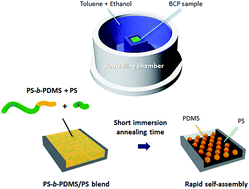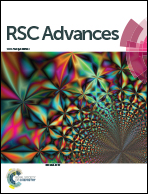Ultra-rapid pattern formation of block copolymers with a high-χ parameter in immersion annealing induced by a homopolymer†
Abstract
The directed self-assembly (DSA) of block copolymers (BCPs) has attracted considerable attention due to the outstanding ability of this method to complement or replace the conventional photolithography process. However, there are critical issues to resolve in order to realize the rapid pattern formation of BCPs with a high Flory–Huggins parameter (χ). Here, we introduce a simple method to expedite the self-assembly kinetics with the addition of a polystyrene homopolymer (hPS) to poly(styrene-b-dimethylsiloxane) (PS-b-PDMS) BCPs with a high-χ parameter. We provide a systematic presentation of how the hPS affects the self-assembly of PS-b-PDMS BCPs in the immersion annealing process. We found the optimum annealing conditions of the mixing ratio for the hPS/PS-b-PDMS BCP blends, showing a very short annealing time (<1 min) to obtain highly-ordered nanostructures. In addition, we discuss how the annealing temperature and mixing ratio of the binary solvent improve the self-assembly kinetics of the hPS/PS-b-PDMS BCP blends, suggesting a new route which effectively enhances the self-assembly speed. We believe that this facile and useful approach is applicable to the other BCP combination studies, contributing to the development of the next-generation BCP lithography.


 Please wait while we load your content...
Please wait while we load your content...